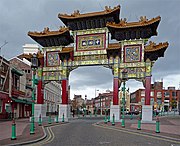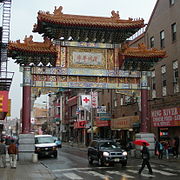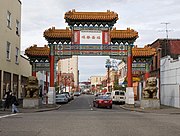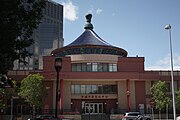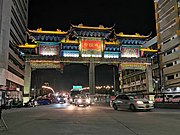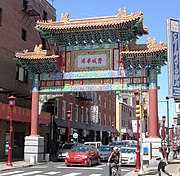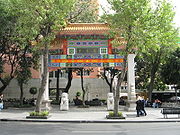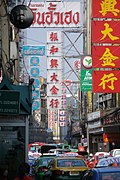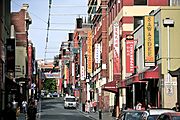Chinatown
| Chinatown | ||
|---|---|---|
BUC | Huà-pú | |
| Chinatowns |
|---|
Chinatown (Chinese: 唐人街) is the catch-all name for an ethnic enclave of Chinese people located outside Greater China, most often in an urban setting. Areas known as "Chinatown" exist throughout the world, including Europe, Asia, Africa, Oceania, and the Americas.
The development of most Chinatowns typically resulted from
Definition
Further ambiguities with the term can include Chinese
History
As conditions in China have improved in recent decades, many Chinatowns have lost their initial mission, which was to provide a transitional place into a new culture. As net migration has slowed into them, the smaller Chinatowns have slowly decayed, often to the point of becoming purely historical and no longer serving as ethnic enclaves.[13]
In Asia

In the
Along the coastal areas of Southeast Asia, several Chinese settlements existed as early as the 16th century according to Zheng He and Tomé Pires' travel accounts. Melaka during the Portuguese colonial period, for instance, had a large Chinese population in Campo China. They settled down at port towns under the authority's approval for trading. After the European colonial powers seized and ruled the port towns in the 16th century, Chinese supported European traders and colonists, and created autonomous settlements.
Several Asian Chinatowns, although not yet called by that name, have a long history. Those in
Chinese presence in India dates back to the 5th century CE, with the first recorded Chinese settler in
The Chinatown centered on Yaowarat Road in Bangkok, Thailand, was founded at the same time as the city itself, in 1782.[22]
Outside of Asia
The
Economic opportunity drove the building of further Chinatowns in the United States. The initial Chinatowns were built in the
The history of Chinatowns was not always peaceful, especially when
In Australia, the
Other Chinatowns in European capitals, including
France received a large settlement of Chinese immigrant laborers, mostly from the city of Wenzhou, in the Zhejiang province of China. Significant Chinatowns sprung up in Belleville and the 13th arrondissement of Paris.
-
nine Chinatown neighborhoods in New York City,[3] as well as one of twelve in the surrounding New York metropolitan area
-
borough with the highest number of Chinatowns in New York City
-
Chinatown, San Francisco, the oldest Chinatown in the US
-
Chinatown, Boston, a Chinatown inspired and developed on the basis of modern engineering concepts
-
Chinatown, Philadelphia, the recipient of significant Chinese immigration from both New York City[34] and China[35]
-
Liverpool's Chinatown, the oldest Chinatown in Europe
1970s to the present
By the late 1970s, refugees and exiles from the Vietnam War played a significant part in the redevelopment of Chinatowns in developed Western countries. As a result, many existing Chinatowns have become pan-Asian business districts and residential neighborhoods. By contrast, most Chinatowns in the past had been largely inhabited by Chinese from southeastern China.
In 2001, the events of September 11 resulted in a mass migration of about 14,000 Chinese workers from Manhattan's Chinatown to Montville, Connecticut, due to the fall of the garment industry. Chinese workers transitioned to casino jobs fueled by the development of the Mohegan Sun casino.
In 2012,
The
The COVID-19 pandemic has adversely affected tourism and business in Chinatown, San Francisco[45] and Chinatown, Chicago, Illinois[46] as well as others worldwide.
Chinese settlements
History
- People of Songkla (Thailand), Malacca (Malaysia), Banten, Semarang, Tuban (Indonesia), Manila (the Philippines), etc. A large number of this kind of settlements was developed along the coastal areal of the South China Sea, and was called "Campon China" by Portuguese account[47] and "China Town" by English account.[48]
Settlement pattern
- The settlement was developed along a jetty and protected by Kuan Ti temple would be added for commercial success, especially by people from Hong Kong and Guangdong province. This core pattern was maintained even the settlement got expanded as a city, and forms historical urban center of the Southeast Asia.[49]
-
Hoian Settlement Pattern, Vietnam, 1991
-
Pengchau Settlement Pattern, Hong Kong, 1991
-
Chinese Settlement in Georgetown, Malaysia, 1991
-
Chinese Settlement in Kuching, Malaysia, 1991
-
Tin Hau (Goddess of Sea) Temple in Kuching, Malaysia, 1991
-
To Di Gong (Land God) Temple at Kuching, 1991
Characteristics
The features described below are characteristic of many modern Chinatowns.
Demographics
The early Chinatowns such as those in San Francisco and Los Angeles in the United States were naturally destinations for people of Chinese descent as migration were the result of opportunities such as the California Gold Rush and the Transcontinental Railroad drawing the population in, creating natural Chinese enclaves that were almost always 100% exclusively Han Chinese, which included both people born in China and in the enclave, in this case American-born Chinese.[50] In some free countries such as the United States and Canada, housing laws that prevent discrimination also allows neighborhoods that may have been characterized as "All Chinese" to also allow non-Chinese to reside in these communities. For example, the Chinatown in Philadelphia has a sizeable non-Chinese population residing within the community.[51]
A recent study also suggests that the demographic change is also driven by
This includes the endangerment of existing historical Chinatowns that will eventually stop serving the needs of Chinese immigrants.Newer developments like those in
Town-Scape
Many tourist-destination metropolitan Chinatowns can be distinguished by large red arch entrance structures known in Mandarin Chinese as
Paifangs usually have special inscriptions in Chinese. Historically, these gateways were donated to a particular city as a gift from the
-
Entrance to Sydney
-
Paifang in Philadelphia
-
Chinatown of Washington, D.C.
-
Paifang in Buenos Aires, Argentina
-
Chinatown, Boston looking towards the paifang
-
Chinatown entry arch inNewcastle, England
-
Chinese Garden of Friendship, part ofSydney Chinatown
-
Chinese stone lions at the Chinatown gate in Victoria, British Columbia, Canada
-
Harbin Gates in Chinatown of Edmonton, Alberta, Canada
-
Millennium Gate on Pender Street in Chinatown of Vancouver, British Columbia, Canada
-
Chinese Temple "Toong On Church" in Kolkata, India.
-
Chinese Temple in Yokohama Chinatown, Japan.
-
Filipino-Chinese Friendship Arch in Manila
Benevolent and business associations

A major component of many Chinatowns is the family benevolent association, which provides some degree of aid to immigrants. These associations generally provide social support, religious services, death benefits (members' names in Chinese are generally enshrined on tablets and posted on walls), meals, and recreational activities for ethnic Chinese, especially for older Chinese migrants. Membership in these associations can be based on members sharing a common
Some examples include San Francisco's prominent
The London Chinatown Chinese Association is active in
Traditionally, Chinatown-based associations have also been aligned with ethnic Chinese business interests, such as restaurant, grocery, and laundry (antiquated) associations in Chinatowns in North America. In Chicago's Chinatown, the On Leong Merchants Association was active.
Names
English

Although the term "Chinatown" was first used in Asia, it is not derived from a Chinese language. Its earliest appearance seems to have been in connection with the Chinese quarter of Singapore, which by 1844 was already being called "China Town" or "Chinatown" by the British colonial government.[54][55] This may have been a word-for-word translation into English of the Malay name for that quarter, which in those days was probably "Kampong China" or possibly "Kota China" or "Kampong Tionghua/Chunghwa/Zhonghua".
The first appearance of a Chinatown outside Singapore may have been in 1852, in a book by the Rev. Hatfield, who applied the term to the Chinese part of the main settlement on the remote South Atlantic island of
One of the earliest American usages dates to 1855, when San Francisco newspaper The Daily Alta California described a "pitched battle on the streets of [SF's] Chinatown".[57] Other Alta articles from the late 1850s make it clear that areas called "Chinatown" existed at that time in several other California cities, including Oroville and San Andres.[58][59] By 1869, "Chinatown had acquired its full modern meaning all over the U.S. and Canada. For instance, an Ohio newspaper wrote: "From San Diego to Sitka..., every town and hamlet has its 'Chinatown'."[60]
In British publications before the 1890s, "Chinatown" appeared mainly in connection with California. At first, Australian and New Zealand journalists also regarded Chinatowns as Californian phenomena. However, they began using the term to denote local Chinese communities as early as 1861 in Australia[61] and 1873 in New Zealand.[62] In most other countries, the custom of calling local Chinese communities "Chinatowns" is not older than the twentieth century.
Several alternate English names for Chinatown include China Town (generally used in
In Chinese

In
A more modern Chinese name is 華埠 (Cantonese: Waa Fau, Mandarin: Huábù) meaning "Chinese City", used in the semi-official Chinese translations of some cities' documents and signs. Bù, pronounced sometimes in Mandarin as fù, usually means seaport; but in this sense, it means city or town. Tong jan fau (唐人埠 "Tang people's town") is also used in Cantonese nowadays. The literal word-for-word translation of Chinatown—Zhōngguó Chéng (中國城) is also used, but more frequently by visiting Chinese nationals rather than immigrants of Chinese descent who live in various Chinatowns.
Chinatowns in Southeast Asia have unique Chinese names used by the local Chinese, as there are large populations of people who are Overseas Chinese, living within the various major cities of Southeast Asia. As the population of Overseas Chinese, is widely dispersed in various enclaves, across each major Southeast Asian city, specific Chinese names are used instead.
For example, in Singapore, where 2.8 million ethnic Chinese constitute a majority 74% of the resident population,[63] the Chinese name for Chinatown is Niúchēshǔi (牛車水, Hokkien POJ: Gû-chia-chúi), which literally means "ox-cart water" from the Malay 'Kreta Ayer' in reference to the water carts that used to ply the area. The Chinatown in Kuala Lumpur, Malaysia, (where 2 million ethnic Chinese comprise 30% of the population of Greater Kuala Lumpur[64]) while officially known as Petaling Street (Malay: Jalan Petaling), is referred to by Malaysian Chinese by its Cantonese name ci4 cong2 gaai1 (茨廠街, pinyin: Cíchǎng Jiē), literally "tapioca factory street", after a tapioca starch factory that once stood in the area. In Manila, Philippines, the area is called Mínlúnluò Qū 岷倫洛區, literally meaning the "Mín and Luò Rivers confluence district" but is actually a transliteration of the local term Binondo and an allusion to its proximity to the Pasig River.
Other languages
In Philippine Spanish, the term used for Chinatown districts is parián, the etymology of which is uncertain.[16] In the rest of the Spanish Empire, the Spanish-language term is usually barrio chino (Chinese neighborhood; plural: barrios chinos), used in Spain and Latin America. (However, barrio chino or its Catalan cognate barri xinès do not always refer to a Chinese neighborhood: these are also common terms for a disreputable district with drugs and prostitution, and often no connection to the Chinese.).
In Portuguese, Chinatown is often referred to as Bairro chinês (the Chinese Neighbourhood; plural: bairros chineses).
In
The Vietnamese term for Chinatown is Khu người Hoa (Chinese district) or phố Tàu (Chinese street). Vietnamese language is prevalent in Chinatowns of Paris, Los Angeles, Boston, Philadelphia, Toronto, and Montreal as ethnic Chinese from Vietnam have set up shop in them.
In Japanese, the term "chūkagai" (中華街, literally "Chinese Street") is the translation used for
In Indonesia, chinatown is known as Pecinan, a shortened term of pe-cina-an, means everything related to the Chinese people. Most of these pecinans usually located in Java.[65]
Some languages have adopted the English-language term, such as Dutch and German.
Locations

Africa
There are three noteworthy Chinatowns in Africa located in the coastal African nations of Madagascar, Mauritius and South Africa. South Africa has the largest Chinatown and the largest Chinese population of any African country and remains a popular destination for Chinese immigrants coming to Africa. Derrick Avenue in Cyrildene, Johannesburg, hosts South Africa's largest Chinatown.
America
In the
The oldest Chinatown in the Americas is in
In Brazil, the Liberdade neighborhood in São Paulo has, along with a large Japanese community, an important Chinese community.[74] There is a project for a Chinatown in the Mercado neighborhood, close to the Municipal Market and the commercial Rua 25 de Março.[75][76][77]
-
San Francisco's Chinatown
-
Portland, Oregon's Chinatown
-
Seattle Chinatown-International District, Seattle
-
Chinatown in Canada's Capital, Ottawa
-
Arch honors Chinese-Mexican community of Mexico City, built in 2008, Articulo 123 Street
Asia
Chinatowns in Asia are widespread with a large concentration of
Vietnam houses the largest
-
Yokohama Chinatown's Goodwill Gate in Japan
-
Chinatown in Bangkok, Thailand
-
Kan Yin Temple (Kwan Yin Si), a place of worship for Burmese Chinese in Bago, also serves as a Mandarin school.
-
Kya-Kya or Kembang Jepun, Surabaya's Chinatown, one of oldest Chinatown in Indonesia
-
The Gate of Kampung Ketandan Chinatown, Yogyakarta, Indonesia
-
Chinese New Year celebrated inChinatown, Kolkata, India
Australia and Oceania
The Chinatown of Melbourne lies within the Melbourne central business district and centers on the eastern end of Little Bourke Street. It extends between the corners of Swanston and Exhibition Streets. Melbourne's Chinatown originated during the Victorian gold rush in 1851, and is notable as the oldest Chinatown in Australia. It has also been claimed to be the longest continuously running Chinese community outside of Asia, but only because the 1906 San Francisco earthquake all but destroyed the Chinatown in San Francisco in California.[69][70][71]
Sydney's main Chinatown centers on Sussex Street in the Sydney downtown. It stretches from Central Station in the east to Darling Harbour in the west, and is Australia's largest Chinatown.
The Chinatown of Adelaide was originally built in the 1960s and was renovated in the 1980s. It is located near Adelaide Central Market and the Adelaide Central bus station.
Chinatown Gold Coast is a precinct in the Central Business District of Southport, Queensland, that runs through Davenport Street and Young Street. The precinct extends between Nerang Street in the north and Garden Street/Scarborough Street east-west. Redevelopment of the precinct was established in 2013 and completed in 2015 in time for Chinese New Year celebrations.
There are additional Chinatowns in Brisbane, Perth, and Broome in Australia.
-
Paifang at Sydney Chinatown
-
Paifang at Bendigo Chinese Precinct
Europe
Several urban Chinatowns exist in major European capital cities. There is Chinatown, London, England as well as major Chinatowns in Birmingham, Liverpool, Newcastle, and Manchester. Berlin, Germany has one established Chinatown in the area around Kantstrasse of Charlottenburg in the West. Antwerp, Belgium has also seen an upstart Chinese community, that has been recognized by the local authorities since 2011.[78] The city council of Cardiff has plans to recognize the Chinese Diaspora in the city.[79]
The
In the United Kingdom, several exist in Birmingham, Liverpool, London, Manchester and Newcastle Upon Tyne. The Chinatown in Liverpool is the oldest Chinese community in Europe.[80] The Chinatown in London was established in the Limehouse district in the late 19th century. The Chinatown in Manchester is located in central Manchester.
-
Map of Chinatown Milan
-
Gate of Chinatown, Liverpool England, is the largest multiple-span arch outside of China, in the oldest Chinese community in Europe.
-
Wardour Street, Chinatown, London
-
Chinese Quarter in Birmingham, England
-
Chinese new year celebration in Lyon, France
In popular culture
Chinatowns have been portrayed in various films including The Joy Luck Club, Big Trouble in Little China, Year of the Dragon, Flower Drum Song, The Lady from Shanghai and Chinatown. Within the context of the last film "Chinatown" is used primarily as an extended metaphor for any situation in which an outside entity seeks to intervene without having the local knowledge required to understand the consequences of that intervention. The neighborhood or district is often associated with being outside the normal rule of law or isolated from the social norms of the larger society.
Chinatowns have also been mentioned in the song "Kung Fu Fighting" by Carl Douglas whose song lyrics says "... There was funky China men from funky Chinatown ..."[81]
The martial arts actor Bruce Lee is well known as a person who was born in the Chinatown of San Francisco.[82] Other notable Chinese Americans such as politician Gary Locke and NBA player Jeremy Lin grew up in suburbs with lesser connections to traditional Chinatowns. Neighborhood activists and politicians have increased in prominence in some cities, and some are starting to attract support from non-Chinese voters.
Some notable temples in Chinatowns worldwide
- (美國舊金山媽祖廟朝聖宮)
- Los Angeles Chinatown – Thien Hau Temple(天后宮)
- Yokohama Ma Zhu Miao(横濱媽祖廟)
- Bangkok Chinatown – Leng Buai Ia Shrine (龍尾古廟), Wat Bamphen Chin Phrot (永福寺) & Wat Mangkon Kamalawat(龍蓮寺)
- Yangon Chinatown – Kheng Hock Keong (慶福宮) & Guanyin Gumiao Temple (觀音古廟)
- Jakarta Chinatown – Kim Tek Ie Temple (金德院)
- Kuala Lumpur Chinatown – Sin Sze Si Ya Temple (仙四師爺廟)
- Malacca Chinatown – Cheng Hoon Teng Temple (青云亭)
- Terengganu Chinatown – Ho Ann Kiong Temple (护安宫) & Tian Hou Gong Temple (天后宮)
- Davao Chinatown – Lon Wa Buddhist Temple (龙华寺)
- Chinatown and Malaytown in Kedah
- Gaya Street, Kota Kinabalu
- Chinatown, Kuching
See also
References
Citations
- ^ a b "Chinatown New York". Civitatis New York. Archived from the original on April 4, 2020. Retrieved November 30, 2020.
As its name suggests, Chinatown is where the largest population of Chinese people live in the Western Hemisphere.
- ^ a b c * "Chinatown New York City Fact Sheet" (PDF). Explore Chinatown. Archived (PDF) from the original on October 9, 2022. Retrieved March 2, 2019.
- Sarah Waxman. "The History of New York's Chinatown". Mediabridge Infosystems, Inc. Archived from the original on May 25, 2017. Retrieved March 3, 2019.
- David M. Reimers (1992). Still the golden door: the Third ... – Google Books. Columbia University Press. ISBN 9780231076814. Archivedfrom the original on November 3, 2023. Retrieved April 11, 2016.
- Lawrence A. McGlinn, Department of Geography SUNY-New Paltz (2002). "Beyond Chinatown: Dual immigration and the Chinese population of metropolitan New York City, 2000, Page 4" (PDF). Journal of the Middle States Division of the Association of American Geographers. Middle States Geographer. pp. 110–119. Archived from the original (PDF) on October 29, 2012. Retrieved March 3, 2019.
- David M. Reimers (1992). Still the golden door: the Third ... – Google Books. Columbia University Press. ISBN 9780231076814. Archivedfrom the original on November 3, 2023. Retrieved April 11, 2016.
- ^ a b c Stefanie Tuder (February 25, 2019). "Believe It or Not, New York City Has Nine Chinatowns". EATER NY. Archived from the original on February 26, 2019. Retrieved November 30, 2020.
- ^ Connecticut's Unexpected Chinatowns. Archived from the original on October 31, 2016 – via YouTube.
- ^ Philip Marcelo. "Fortune, friction and decline as casino 'Chinatown' matures". The Bulletin. The Associated Press.[permanent dead link]
- ^ "Definition of Chinatown". Archived from the original on February 28, 2014.
- ^ "Where You Live Chinatown". Archived from the original on March 1, 2014.
- ISBN 9780816654857.
- ^ "Archived copy". Archived from the original on March 4, 2016. Retrieved February 21, 2016.
{{cite web}}: CS1 maint: archived copy as title (link) - ^ "Ethnoburb: The New Ethnic Community in Urban America". Archived from the original on March 3, 2014.
- ^ "Asians in Thriving Enclaves Keep Distance From Whites". Bloomberg.com. June 26, 2013. Archived from the original on January 22, 2015. Retrieved May 2, 2018.
- ^ Tsui, Bonnie (January 24, 2014). "Chinatown Revisited". The New York Times. Archived from the original on July 6, 2017.
- ^ "From Chinatown to Ghost Town". NHPR. November 14, 2011. Archived from the original on November 1, 2013. Retrieved May 26, 2013.
- ^ Dela Cerna, Madrilena. "Parian in Cebu". National Commission for Culture and the Arts. Republic of the Philippines. Archived from the original on February 24, 2014. Retrieved October 12, 2023.
{{cite web}}: CS1 maint: bot: original URL status unknown (link) - ^ "The Parian and the Spanish Colonial Economy". Intramuros Administration, Republic of the Philippines. Archived from the original on October 29, 2023. Retrieved October 12, 2023.
- ^ a b Burton, John William (2000). "The Word Parian: An Etymological and Historical Adventure". The Ethnic Chinese as Filipinos (Part III). 8: 67–72. Archived from the original on October 29, 2023. Retrieved October 12, 2023.
- ISBN 9781456775438.
- ^ Takekoshi, Yosaburo (2004). economic aspects of the history of the civilization of Japan, Vol. 2. London: Routledge. p. 124.
- ^ Li, Qingxin (2006). Maritime Silk Road. China International Press. p. 157.
- ^ Abeyesekere, Susan (1987). Jakarta: A History. Oxford University Press. All rights reserved. p. 6.
- ^ "Calcutta's Chinatown facing extinction over new rule". Taipei Times. July 31, 2004. Archived from the original on May 13, 2011. Retrieved May 2, 2018.
- ^ "The History of Chinatown Bangkok". Yaowarat Chinatown Heritage Center. Archived from the original on September 20, 2011. Retrieved October 2, 2011.
- ^ "Chinatown Melbourne". Archived from the original on January 25, 2014. Retrieved January 23, 2014.
- ^ "Melbourne's multicultural history". City of Melbourne. Archived from the original on September 30, 2023. Retrieved January 23, 2014.
- ^ "World's 8 most colourful Chinatowns". Archived from the original on January 31, 2014. Retrieved January 23, 2014.
- ^ "The essential guide to Chinatown". Melbourne Food and Wine Festival. Food + Drink Victoria. February 3, 2021. Archived from the original on February 14, 2022. Retrieved February 11, 2022.
- ^ "History of Liverpool Chinatown". The Liverpool Chinatown Business Association. Archived from the original on January 24, 2010. Retrieved January 31, 2011.
- ^ Documentary film about the early history of San Francisco's Chinatown Archived 2014-01-06 at the Wayback Machine, KPIX-TV, 1963.
- ]
- ^ Roenfeld, R. (2019) "A History of Omaha's Chinatown Archived March 6, 2019, at the Wayback Machine, NorthOmahaHistory.com. Retrieved March 5, 2019.
- ISBN 978-0-520-27435-8. Archivedfrom the original on May 2, 2018.
- ^ "Chinatown". Dictionary of Sydney. Archived from the original on April 27, 2019. Retrieved October 26, 2019.
- ^ Sales, Rosemary; d'Angelo, Alessio; Liang, Xiujing; Montagna, Nicola. "London's Chinatown" in Donald, Stephanie; Kohman, Eleonore; Kevin, Catherine. (eds) (2009). Branding Cities: Cosmopolitanism, Parochialism, and Social Change Archived February 12, 2024, at the Wayback Machine. Routledge. pp. 45–58.
- ^ Matt Katz (July 20, 2018). "Leaving New York to Find the American Dream in Philadelphia". The New York Times. Archived from the original on August 7, 2018. Retrieved November 10, 2019.
- ^ Jeff Gammage (May 10, 2019). "Welcome to Philly: Percentage of foreign-born city residents has doubled since 1990". The Philadelphia Inquirer. Archived from the original on May 10, 2019. Retrieved November 10, 2019.
China is, far and away, the primary sending country, with 22,140 city residents who make up about 11 percent of the foreign-born population, according to a Pew Charitable Trusts analysis of Census data.
- ^ Melia Robinson (May 27, 2015). "This is what it's like in one of the biggest and fastest growing Chinatowns in the world". Business Insider. Archived from the original on July 30, 2017. Retrieved March 3, 2019.
- The Guardian US. Archivedfrom the original on August 13, 2020. Retrieved August 13, 2020.
The three developers have stressed in public hearings that they are not outsiders to Flushing, which is 69% Asian. 'They've been here, they live here, they work here, they've invested here,' said Ross Moskowitz, an attorney for the developers at a different public hearing in February...Tangram Tower, a luxury mixed-use development built by F&T. Last year, prices for two-bedroom apartments started at $1.15m...The influx of transnational capital and rise of luxury developments in Flushing has displaced longtime immigrant residents and small business owners, as well as disrupted its cultural and culinary landscape. These changes follow the familiar script of gentrification, but with a change of actors: it is Chinese-American developers and wealthy Chinese immigrants who are gentrifying this working-class neighborhood, which is majority Chinese.
- ^ Justin Davidson (December 15, 2022). "Can the Hochul-Adams New New York Actually Happen?". Curbed - New York magazine. Archived from the original on December 18, 2022. Retrieved December 18, 2022.
- ^ Eileen Sullivan (November 24, 2023). "Growing Numbers of Chinese Migrants Are Crossing the Southern Border". The New York Times. Archived from the original on November 25, 2023. Retrieved November 24, 2023.
Most who have come to the United States in the past year were middle-class adults who have headed to New York after being released from custody. New York has been a prime destination for migrants from other nations as well, particularly Venezuelans, who rely on the city's resources, including its shelters. But few of the Chinese migrants are staying in the shelters. Instead, they are going where Chinese citizens have gone for generations: Flushing, Queens. Or to some, the Chinese Manhattan..."New York is a self-sufficient Chinese immigrants community," said the Rev. Mike Chan, the executive director of the Chinese Christian Herald Crusade, a faith-based group in the neighborhood.
- ^ "Selected Population Profile in the United States 2017 American Community Survey 1-Year Estimates New York-Newark, NY-NJ-CT-PA CSA Chinese alone". United States Census Bureau. Archived from the original on February 14, 2020. Retrieved March 3, 2019.
- ^ "Yearbook of Immigration Statistics: 2011 Supplemental Table 2". U.S. Department of Homeland Security. April 13, 2016. Archived from the original on August 8, 2012. Retrieved March 3, 2019.
- ^ "Yearbook of Immigration Statistics: 2010 Supplemental Table 2". U.S. Department of Homeland Security. Archived from the original on July 12, 2012. Retrieved April 10, 2011.
- ^ John Marzulli (May 9, 2011). "Malaysian man smuggled illegal Chinese immigrants into Brooklyn using Queen Mary 2: authorities". New York Daily News. New York. Archived from the original on May 5, 2015. Retrieved March 3, 2019.
- ^ Kulish, Nicholas; Robles, Frances; Mazzei, Patricia (March 2, 2019). "Behind Illicit Massage Parlors Lie a Vast Crime Network and Modern Indentured Servitude". The New York Times. Archived from the original on March 6, 2019. Retrieved March 3, 2019.
- ^ Jada Chin (November 30, 2020). "The country's oldest Chinatown is fighting for its life in San Francisco Covid-19 has decimated tourism in the neighborhood. Can its historic businesses survive?". The Washington Post. Archived from the original on December 2, 2020. Retrieved December 3, 2020.
- ^ Robert Channick (February 12, 2020). "Chicago's Chinatown takes a hit as coronavirus fears keep customers away. Business is down as much as 50% at some restaurants". Herald & Review. Archived from the original on April 27, 2021. Retrieved December 3, 2020.
- ^ 1613 Description of Malaca and Meridional India and Cathay composed by Emanuel Godinho de Eradia.
- ^ "We firſt paſſed the lower ground, from thence round the Horſe Stable Hill, to the Hermitage, and ſo by the China Town and brick-ſhades," Modern Hiſtory: Bing a Continuation of the Universal History, Book XIV, Chap. VI. Hiſtory of the Engliſh Eaſt India Company, 1759.
- ISBN 978-89-5933-712-5(Korean version)
- ^ "Chinatown Area Plan (San Francisco Chinatown)". Archived from the original on May 19, 2014.
- ^ "Chinatown Philadelphia PA". Archived from the original on July 2, 2014.
- ^ "China City Of America: New Disney-Like Chinese-Themed Development Plans To Bring $6 Billion To Catskills In New York State". International Business Times. December 6, 2013. Archived from the original on March 7, 2014.
- ^ "U.S. Census website". Archived from the original on December 27, 1996. Retrieved April 4, 2020.
- ^ "Trade and Commerce in Singapore". Simmond's Colonial Magazine and Foreign Miscellany: 335. January–April 1844. Archived from the original on December 22, 2011. Retrieved December 20, 2011.
- ^ Sydney Morning Herald. July 23, 1844. p. 2.
{{cite news}}: Missing or empty|title=(help) - ^ Hatfield, Edwin F. (1852). St. Helena and the Cape of Good Hope. p. 197.
- ^ Alta California. December 12, 1855. p. 1.
{{cite news}}: Missing or empty|title=(help) - ^ Alta California. December 12, 1857. p. 1.
{{cite news}}: Missing or empty|title=(help) - ^ Alta California. June 4, 1858. p. 2.
{{cite news}}: Missing or empty|title=(help) - ^ Defiance Democrat. June 12, 1869. p. 5.
{{cite news}}: Missing or empty|title=(help) - ^ Ballarat Star. February 16, 1861. p. 2.
{{cite news}}: Missing or empty|title=(help) - ^ Tuapeka Times. February 6, 1873. p. 4.
{{cite news}}: Missing or empty|title=(help) - ISBN 9789810878085. Archived from the original(PDF) on February 13, 2020. Retrieved December 29, 2019.
- ^ Department of Statistics, Malaysia. "Migration and Population Distribution 2010" Archived 2020-02-06 at the Wayback Machine, Government of Malaysia, Malaysia, August 2014. Retrieved on 27 December 2019.
- ISBN 9789400754829. Archivedfrom the original on February 12, 2024. Retrieved November 9, 2020.
- ^ "SELECTED POPULATION PROFILE IN THE UNITED STATES 2017 American Community Survey 1-Year Estimates New York-Newark, NY-NJ-CT-PA CSA Chinese alone". United States Census Bureau. Archived from the original on February 14, 2020. Retrieved January 27, 2019.
- ^ Kirk Semple (June 23, 2011). "Asian New Yorkers Seek Power to Match Numbers". The New York Times. Archived from the original on December 19, 2014. Retrieved October 3, 2014.
- ^ a b Lawrence A. McGlinn (2002). "Beyond Chinatown: Dual Immigration and the Chinese Population of Metropolitan New York City, 2000" (PDF). Middle States Geographer. 35 (1153): 4. Archived from the original (PDF) on October 29, 2012. Retrieved October 3, 2014.
- ^ a b Bacon, Daniel: Walking the Barbary Coast Trail 2nd ed., page 50, Quicksilver Press, 1997
- ^ a b Richards, Rand: Historic San Francisco, 2nd Ed., page 198, Heritage House Publishers, 2007
- ^ a b Morris, Charles: San Francisco Calamity by Earthquake and Fire, pgs. 151-152, University of Illinois Press, 2002
- ^ "Chinatown Vancouver Online". Vancouver Chinatown. Archived from the original on September 3, 2011. Retrieved September 11, 2011.
- ISBN 978-0-307-27824-1. Archivedfrom the original on February 12, 2024. Retrieved October 12, 2012.
- ^ "A Chinatown brasileira". May 12, 2015. Archived from the original on December 26, 2023. Retrieved December 26, 2023.
- ^ "Revitalização do Centro de SP: Conheça o projeto Chinatown". January 4, 2023. Archived from the original on December 26, 2023. Retrieved December 26, 2023.
- ^ "O Globo destaca projeto da Chinatown São Paulo". June 5, 2023. Archived from the original on December 26, 2023. Retrieved December 26, 2023.
- ^ "Opinião - José Ruy Gandra: A Chinatown paulistana". November 11, 2021. Archived from the original on December 26, 2023. Retrieved December 26, 2023.
- ^ "China Town Antwerpen". Chinatown-antwerpen.be. Archived from the original on September 20, 2011. Retrieved September 11, 2011.
- ^ "What happened to Cardiff Chinatown? - Discussion Board". Britishchineseonline.com. October 5, 2005. Archived from the original on March 28, 2012. Retrieved September 11, 2011.
- ^ "Liverpool and it's Chinese Children". Halfandhalf.org.uk. Archived from the original on October 2, 2011. Retrieved September 11, 2011.
- ^ Carl Douglas. Kung Fu Fighting.
- ^ Ohanesian, Liz (February 12, 2015). "Bruce Lee's Huge Bronze Statue Turns Into a Mecca in L.A.'s Chinatown (VIDEO)". laweekly.com. Archived from the original on January 4, 2018. Retrieved May 2, 2018.
Sources
- Chew, James R. "Boyhood Days in Winnemucca, 1901–1910." Nevada Historical Society Quarterly 1998 41(3): 206–209. ISSN 0047-9462 Oral history (1981) describes the Chinatown of Winnemucca, Nevada, during 1901–10. Though many Chinese left Winnemucca after the Central Pacific Railroad was completed in 1869, around four hundred Chinese had formed a community in the town by the 1890s. Among the prominent buildings was the Joss House, a place of worship and celebration that was visited by Chinese revolutionist Sun Yat-Sen in 1911. Beyond describing the physical layout of the Chinatown, the author recalls some of the commercial and gambling activities in the community.
- ISBN 0975925571, San Francisco's Chinatown during the 1906 earthquake and in the early 1920s. (Eio Books)
- "Chinatown: Conflicting Images, Contested Terrain", K. Scott Wong, Melus (Vol. 20, Issue 1), 1995. Scholarly work discussing the negative perceptions and imagery of old Chinatowns.
- Pan, Lynn. Sons of the Yellow Emperor: A History of the Chinese Diaspora (1994). Book with detailed histories of Chinese diaspora communities (Chinatowns) from San Francisco, Honolulu, Bangkok, Manila, Johannesburg, Sydney, London, Lima, etc.
- Williams, Daniel. "Chinatown Is a Hard Sell in Italy", The Washington Post Foreign Service, March 1, 2004; Page A11.
Further reading
- Kwan, Cheuk (2023). Have you eaten yet? : stories from Chinese restaurants around the world (First Pegasus Books cloth ed.). New York: Pegasus Books. ISBN 9781639363346.

![Manhattan's Chinatown, the largest concentration of Chinese people in the Western Hemisphere[1][2] and one of nine Chinatown neighborhoods in New York City,[3] as well as one of twelve in the surrounding New York metropolitan area](http://upload.wikimedia.org/wikipedia/commons/thumb/f/f5/Chinatown_manhattan_2009.JPG/180px-Chinatown_manhattan_2009.JPG)

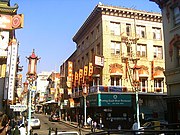

![Chinatown, Philadelphia, the recipient of significant Chinese immigration from both New York City[34] and China[35]](http://upload.wikimedia.org/wikipedia/commons/thumb/d/d0/Friendship_Gate_Chinatown_Philadelphia_from_west.jpg/180px-Friendship_Gate_Chinatown_Philadelphia_from_west.jpg)
